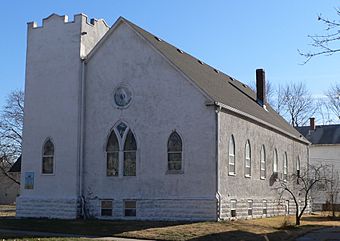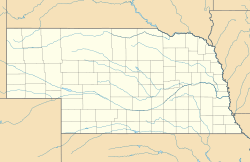Quinn Chapel African Methodist Episcopal Church and Parsonage facts for kids
Quick facts for kids |
|
|
Quinn Chapel African Methodist Episcopal Church and Parsonage
|
|

The chapel in 2012
|
|
| Location | 1225 South 9th Street, Lincoln, Nebraska |
|---|---|
| Area | less than one acre |
| Built | 1905 |
| Built by | A.L. Hansen |
| Architect | A.W. Woods |
| Architectural style | Late Gothic Revival, American foursquare |
| MPS | African American Historic and Architectural Resources in Lincoln, Nebraska MPS |
| NRHP reference No. | 99000749 |
| Added to NRHP | June 25, 1999 |
The Quinn Chapel African Methodist Episcopal (AME) Church was the very first church for Black people in Lincoln, Nebraska. It has a long and important history in the community. The church building and its nearby parsonage (a house for the minister) are recognized as historic places.
Contents
The History of Quinn Chapel
How the Church Started
The Quinn Chapel AME Church began in 1870. A group of people started meeting in their homes. They met with a traveling minister. In 1871, Reverend G. W. Gaines officially organized the church. This meant it became a formal church group.
Early Church Buildings
The first church building for the congregation was built in 1889. It was located between 10th and 11th Streets on E Street. This building was two and a half stories tall. It also had a tall spire that reached 60 feet into the sky.
In 1899, the church lost that building. The congregation then moved to a different place. They used a two-story apartment building at 1026 F Street. This building was renovated to serve as their new church.
Building the Current Chapel
In 1905, the church built a new structure on F Street. This is the main chapel building we know today. Later, in 1915, this building was moved. It was carefully relocated to its current address at 925 C Street.
Design and Architecture
The chapel was built by A. L. Hansen in 1905. It was designed in the Gothic Revival style. This style often includes pointed arches and tall windows. In 1926, architect A. W. Woods redesigned parts of the chapel.
The parsonage, which is the minister's house, was built later in 1923. It was designed in the American Foursquare style. This style is known for its simple, boxy shape. Both the chapel and the parsonage are connected to the African Methodist Episcopal Church.
A Historic Landmark
The Quinn Chapel African Methodist Episcopal Church and Parsonage is a very important historic site. It was officially added to the National Register of Historic Places on June 25, 1999. This listing means the property is recognized for its historical importance. It helps protect the buildings for future generations.
References



